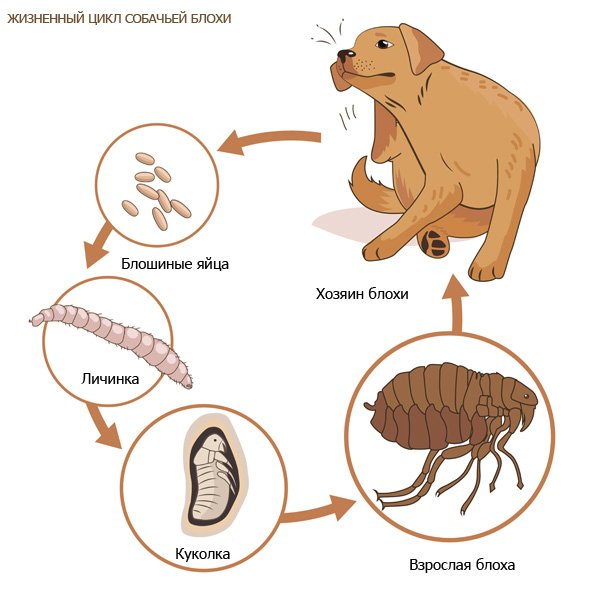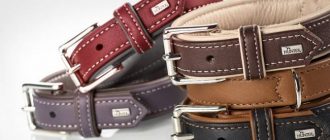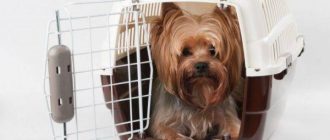Fleas are the most common among ectoparasites (parasites living on the surface of the body) delivering to the four-legged Pet suffering a lot. Moreover, the danger of infection lies in wait not only homeless animals, but also those who live in the apartment and has responsible owners. Besides the discomfort, experienced by a dog (itching, nervousness, loss of appetite), eat a real chance to catch any endoparasitis (viruses, helminths, bacteria). Fleas are carriers of such diseases like salmonellosis, brucellosis, hepatitis. That’s why lack of proper flea invasion treatment may not result only to a deterioration in the quality of life, but even to death due to complications. Hope for an independent disposal of fleas not necessary – the females release onto the skin and hair of the wearer, as well as into the environment (for dog bedding, bowls, furniture, soil) many eggs, which subsequently become the same bloodsuckers.
Causes of the appearance of fleas in a dog
Contents
Even the most well-groomed dog can catch fleas everywhere. Moreover, the new “friends” of the dog will annoy not only her, but also other household members – family members of the owner, warm-blooded animals and rodents. Яйца блох могут подстерегать животное:
- В траве, почве – когда собака выходит на прогулку;
- In the nests of birds and burrows of wild animals;
- In the trash;
- In excrement and housing of poultry (chickens, ducks, geese);
- Upon contact with an infected animal.
Often, flea eggs are brought into the house by the owner himself on shoes and clothes. Favorable environment for the development of fleas (transformation from an egg in a larva, a chrysalis, and then an adult) – warm rooms (from +20 to + 25 ° С) with a high level of humidity (50-100%). I.e the dog is in danger almost everywhere.
Symptoms of fleas in a dog
How to find out what an animal has fleas? Notice flea animal easy as there are many ways to determine if parasites. By visual inspection of the dog and holding it by hand (or with a brush) against the coat you can see small white grains – this flea eggs. Dark brown particles are excrement of parasites, undigested blood. If there are a lot of fleas on the animal’s body, then adults can be detected with the naked eye – small (not more than 1-2 mm) dark brown color of jumping and agile pests. In addition to the external evidence of fleas (and their products life activity, offspring) the owner can observe such dog symptoms:
- The animal often itches and nibbles its body;
- Places of bites have a reddish tint;
- Scratches, ulcers, foci of baldness and bite marks on the body dogs;
- Increased anxiety (refusal of food, lack of interest in games, intermittent sleep);
- Weakness;
- Mournful whining.
Since ectoparasites contribute to other complex diseases, gastrointestinal tract disorders may be gradually added to the main symptoms, fever, pathological impurities in the feces, a change in the shade of mucous surfaces and other dangerous bells. This is why flea prevention and treatment should be carried out. with all responsibility on the part of the owner
Getting rid of fleas, eggs, and larvae
Whatever treatment the owner chooses without due care insecticidal treatment of the room can not do. Because fleas (a more precisely, their eggs) can be present not only on the body of the animal, but throughout the apartment, the owner will have to make a thorough wet cleaning, take out garbage, free hard-to-reach places (behind carpets, furniture). As a lifesaver insecticidal products designed for animals are suitable. Not bad there are such means – “Get”, “Agita 10 WG”, dust, “Master 250 ISS “. Instructions for use (including action on the body human and animal, the need to flush insecticide) should be studied by the owner before use. If the animal lives in the yard, then the aviary and the booth must be processed insecticidal agents. In this case, it is desirable to choose this a tool that does not harm the health of the dog.
Treating a dog for fleas at home
Before proceeding with the removal of parasites, it is necessary to wash animal. To do this, you can purchase insecticidal special shampoo (“Fitoelita”, “Green fort”, “SENTRY Natural Defense”) or tar soap. After washing, the animal should be well dried and combed out.  Canine life cycle fleas.
Canine life cycle fleas.
Folk remedies against fleas
Flea control agents are sometimes used. folk remedies. True, they are more likely to temporarily scare off fleas. If there are too many parasites on the animal’s body, it’s unlikely that grass and decoctions will cope with the task of eliminating bloodsuckers. One of wormwood is considered the best herbs for fighting fleas. Broth (from calculation of 1 tbsp. boiling water for 10 gr. dry leaves) rubbed into the skin animal. Under a laying of a dog, in the territory of an open-air cage or in the apartment can be laid out fresh wormwood, unpleasant for ectoparasites. As a means to combat fleas also use a decoction of tansy, wormwood and eucalyptus, which is moistened the dog’s hair, and then thoroughly combed out. Sometimes used garlic (1 chopped clove per 1 tbsp of water), lavender, rosemary or geranium oil whose aroma is unpleasant fleas. Since it is not known how the body will react dogs for treatment with folk remedies, it is recommended pre-treat a small area of the body in order to avoid allergic reactions.
Synthetic flea control
Effective insecticides against fleas are considered synthetic products allowing for some time guaranteed to save the dog from uninvited guests. The most popular ones are:
- Sprays (“Frontline”, “Delix”, “Bolfo”) – one of the most effective means to combat fleas. Spraying them leads to the formation of a protective film on the body of the animal, paralyzing and poisonous fleas. The action of the spray usually lasts for some weeks. However, such a powerful tool is not recommended. use for puppies (under 6-8 months), pregnant and lactating bitches;
- Drops (“Beaphar bio”, “Celandine”) – are used in areas of the withers of the animal, which is convenient in cases where the dog will try to lick the drug. You can pick up the drops created for puppies from 2 months. Drops are not recommended for patients and weakened animals;
- Collars against fleas (“Doctor zoo”, “Celandine”, “Foresto”) – are divided into ultrasonic, chemical and biological. The benefits of ultrasound in the absence of sharp odor and harmful chemical constituents. However, during operation, the device will make a light sound, in addition, the cost of such a collar will be quite high (at least 1000 rubles.). Chemical collars have a pungent odor, but they are considered the most effective (up to until the expiration date). Biological collars are positioned as harmless, since during their manufacture Aromatic oils are used. By the way, often enough animals try to get rid of unpleasant smelling chemicals and biological collars. The above products often cause allergic reactions;
- Flea chewable tablets (“Bravecto”, “Frontline”) – help get rid of fleas within 8 hours after ingestion. Some remedies can be used for puppies, pregnant and lactating bitches.
Often, anti-flea drugs successfully cope with other bloodsuckers – ticks. For prophylaxis (preferably after coordination with the veterinarian) fleas are destroyed twice a year – in spring and autumn. If the dog suffers from an attack parasites, then you should not hesitate with treatment. Moreover, the rate in any case should be done on the safety of the anti-flea funds for the dog, and already the effectiveness will have to be put on second stage. Moreover, the removal of fleas is mandatory before deworming procedure. Fleas are the intermediate hosts of many helminths, which is why the destruction of worms without advance flea elimination procedures will not have proper actions.






